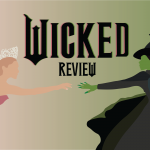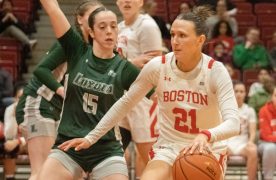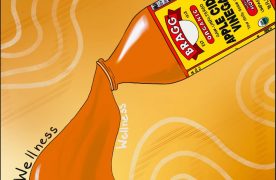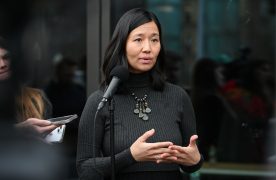Esteemed against sunflower-yellow walls, portraits of Black women wearing natural hairstyles received a warm welcome alongside their creator, Maya Alia. Such a celebration of Black hair calls for celebration, after all.
“Curls & Coils,” an exhibit displaying the art of Cambridge native Alia, opened on Sept. 12 and held its reception at Harvard Ed Portal’s Crossing Gallery in Allston on Sept. 19. The exhibit will close on Oct. 24.
Alia is a multidisciplinary artist whose digital illustrations feature Black women with a variety of hairstyles and textures, with the mission of empowering women to embrace their natural hair.

“I knew that this collection could be profound if shared,” Alia said. “It touches on so many people’s [stories].”
Alia is the founder and manager of AIRI Jewelry and Gallery, where she sells prints of her art and handmade wire earrings. There was an AIRI pop-up shop at the opening reception where attendees could purchase some of Alia’s work.
Before she was an artist by trade, Alia was an event planner for a non-profit in Boston. Post-pandemic, Alia said she spent her lockdown discovering how much she enjoyed making jewelry and illustrating with Procreate.
One piece in the exhibit, titled “Unapologetic,” depicts a woman with two flat hair twists blossoming into an Afro and a flower tucked behind her ear, which Alia said represents justice.
Alia said that flowers were used historically to share messages, and the many floral accents in her work embody that.
“With the symbolic flowers, I wanted to, one, portray a message, and two, I wanted to give a second meaning to what people may assume [from my work],” Alia said.
Other floral motifs on display are her “Daisy Earrings,” a pair of brass wire ear jackets hand-bent by Alia.
Almost every piece featured in “Curls & Coils” is either a pair of earrings or a digital illustration.
Tucked in the corner, a computer monitor plays a silent video installation on repeat, where the incomplete phrase “Don’t ___ My Hair” remains static on the screen. Words including “police,” “disempower,” “poison” and more rotate to fill in the blank space, creating new sentences every second or so.
Alia said part of the inspiration for the video installation was the pressure she felt to chemically straighten her hair.
“These products are geared towards people of color [and] people with curly hair textures, coily hair textures,” Alia said. “Why are we hurting ourselves to meet beauty standards?”
Gabriella Melchiorri, arts program coordinator at Harvard Ed Portal, said that the video installation, like the rest of the exhibit, allowed the viewers to see themselves in Alia’s art.
“If someone is really viewing her work … you can insert your own vision of who [the art] is depicting,” Melchiorri said. “Whether it be in your own personal life experience or a family member or a friend.”
Melchiorri said it stood out to her that most of the subjects of Alia’s art did not have faces.
Ajani Hickling, a photographer and Boston University sophomore, expressed appreciation for how “Curls & Coils” uplifts hair diversity.
“It provides a space for representation that you don’t see often,” Hickling said. “It’s not only featuring women of color, but it’s also putting direct emphasis on their hair.”
Ligia Sibauste, a BU sophomore, said she appreciated how Alia framed her images in a “beautiful feminine light,” with bright color schemes and flowers.
“You really don’t tend to see in art and in photography Black women and women of color being framed in a light of femininity and delicacy,” Sibauste said.
Sibauste commended Alia for curating a space to honor the beauty of textured hair. As the only member of her family with curly hair, Sibauste said a lack of representation of hair texture affected her.
“Being Hispanic, there’s a lot of desire to have straight hair,” Sibauste said. “[Alia’s artwork] would have been nice to have seen for me.”
Alia said caring for natural hair “breeds confidence” and that “Curls & Coils” was created to do the same.
“If you’re thinking about going natural and you have some type of hesitation, think about what that fear is,” Alia said “If it’s fear about how you’re going to be perceived, then this is what this collection is about.”














